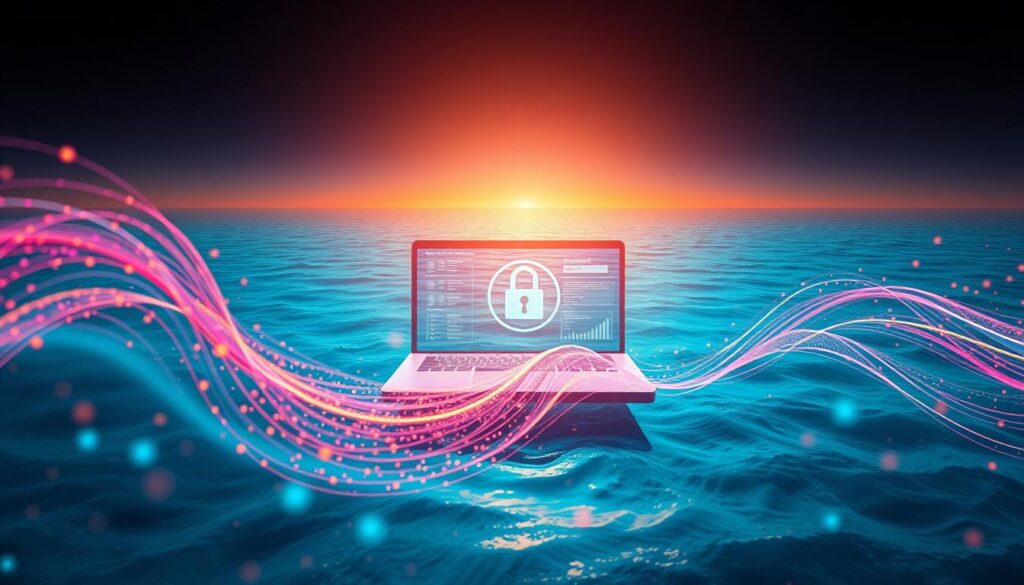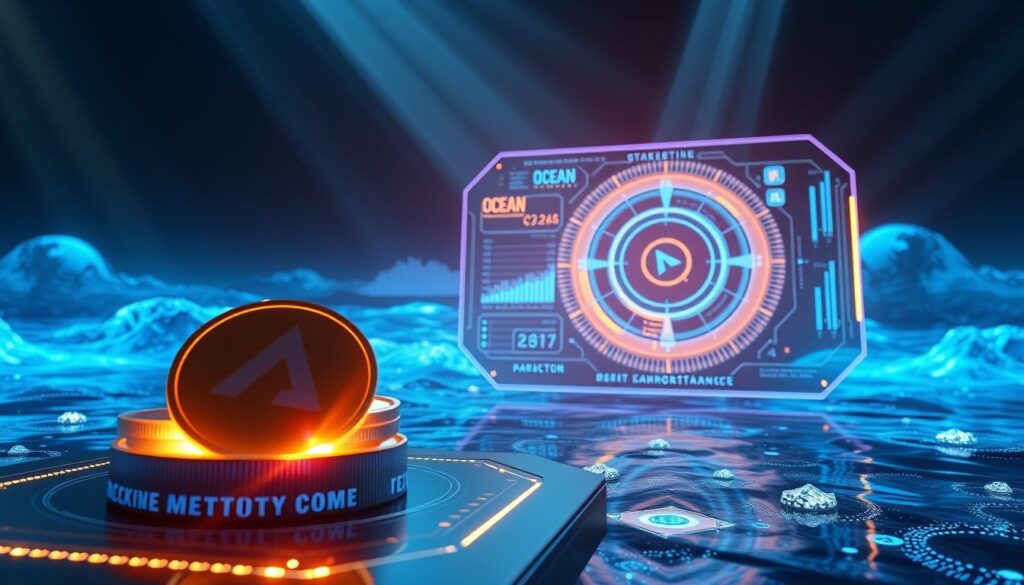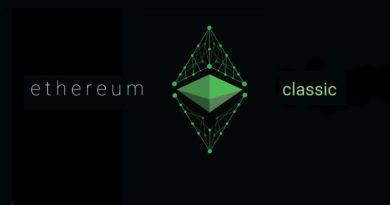Ocean Protocol (OCEAN): Empowering Data Economies of the Future
Between April 2021 and August 2023, Ocean Protocol’s value dropped by over 80%. But its dream to change how we handle data worldwide is alive. It’s a platform that makes data something you can trade, share safely, and earn from.
It combines AI, blockchain, and data science to solve big problems like data being stuck in silos and privacy issues. With the data economy now worth $11 trillion, Ocean Protocol wants to help it grow. Big companies like Daimler and Johnson & Johnson are already looking for ways to manage their data costs, which Ocean Protocol can help with.
Started in 2017 by Bruce Pon and Trent McConaghy, Ocean Protocol has a unique setup. It uses smart contracts, tools for developers, and apps. The OCEAN token powers this system, rewarding users for their long-term commitment.
Even though predictions for its token’s price vary, its impact on fields like healthcare and logistics is clear. It’s working with big names like Siemens, IBM, and EU projects like GAIA-X. This shows it’s making a real difference.
Key Takeaways
- Ocean Protocol’s blockchain enables secure data transactions worth billions annually.
- Its OCEAN token’s value dropped 82% from 2021 but is expected to grow in the long run.
- The protocol’s architecture supports AI, IoT, and decentralized data marketplaces.
- Major corporations and governments like Singapore and the EU collaborate with its technology.
- Data Farming and veOCEAN mechanisms incentivize user participation and liquidity.
What is Ocean Protocol (OCEAN) and Why It Matters
Launched in 2017, Ocean Protocol was created to fight against data control by big tech companies. Bruce Pon and Trent McConaghy wanted to make a system where data could move freely. By 2016, the world was producing 16 zettabytes of data, showing the need for fair data systems.
The Origin Story of Ocean Protocol
In Singapore, Ocean Protocol Foundation brought together tech experts and business minds to solve data inequality. They knew 80% of global data was unused because it was hard to access. The first big step was the Marketplace Framework, which started data sharing on blockchain networks like Polygon and Binance Smart Chain.
Core Mission and Vision
“Data should empower everyone, not just a few corporations,” states the team’s vision. Ocean Protocol aims to open up AI-driven data economies through decentralized markets. By 2023, it had 2 million monthly transactions on Ocean Predictoor alone.
The Team Behind Ocean Protocol
Leaders Bruce Pon and Trent McConaghy have a strong background in tech. In 2023, the team made big strides with 5,638 code commits and 1,834 pull requests. They also have advisors from MIT and Stanford, ensuring they stay on top of data trends.
With Singapore’s IMDA as a partner, Ocean Protocol has grown a lot. It now has 175k Twitter followers and is working on real projects like helping Singapore’s elderly. This makes it a key player in changing how data is shared and valued.
Understanding the Technology Behind Ocean Protocol
Ocean Protocol uses blockchain technology for a secure data exchange system. It has three main layers: smart contracts, libraries, and applications. This setup makes it easy to share data across different networks.
- Smart Contracts Layer: Manages datatokens (ERC-20) and data NFTs (ERC-721), enabling programmable access rights.
- Libraries Layer: Provides tools for developers to build custom data-sharing workflows.
Application Layer: Hosts user interfaces for data buyers and sellers to interact directly.
The blockchain is key to Ocean Protocol’s data exchange. Users can buy datatokens with crypto wallets. Data providers create data NFTs, keeping metadata on-chain and data off-chain for safety.
Ocean Protocol works with Ethereum Virtual Machine (EVM) chains like Polygon and Moonriver. It has a Compute-to Data feature for AI research. This keeps data safe while allowing analysis.
Steps like payment confirmation and credential checks protect data access. The system also fits with cloud platforms like AWS. This connects Web2 and Web3 worlds.
How Ocean Protocol Revolutionizes Data Sharing
Data sharing on Ocean Protocol changes how we trade information. It focuses on security and control. Unlike old systems, it lets users keep their data while making it accessible worldwide. Here’s how it works:
Decentralized Data Exchange Explained
- Users register data via URLs, linking assets to blockchain-registered NFTs.
- Data owners set terms like access fees or usage limits through smart contracts.
- Compute-to-Data lets algorithms process datasets without exposing raw data, safeguarding privacy.
Privacy and Security Features
Encryption and access controls keep data safe. Only those with permission can access it. Ocean Protocol’s design keeps sensitive info hidden, lowering the risk of breaches.
Aethir’s 400,000 GPU containers across 95 countries power secure computations without data exposure.
Smart Contracts and Data Monetization
Data providers earn Ocean Protocol tokens by setting prices. They can choose one-time payments or subscriptions. Smart contracts handle revenue splits and royalties, cutting out middlemen.
Users pay with OCEAN tokens for access. Token holders can stake to secure the network or vote on ecosystem decisions.
Data sovereignty and AI innovation go hand-in-hand. Ocean Protocol’s infrastructure empowers creators without compromising security.
By combining blockchain with real-world uses, Ocean Protocol creates a future where data sharing is both open and profitable.
Key Benefits of the Ocean Protocol Ecosystem

Ocean Protocol’s ecosystem brings big wins for data users. It makes it easy to share and earn from data, giving users control over their assets. The Compute-to Data model keeps sensitive data safe, which is key for healthcare and finance.
| Benefit | Description |
|---|---|
| Data Democratization | Breaks down silos, letting anyone access diverse datasets via the Ocean Protocol data exchange. |
| Monetization Tools | Data providers earn through Datatokens and Data NFTs, which represent ownership and access rights on-chain. |
| Trust & Security | Blockchain-based transactions ensure transparency, while privacy tools protect user data during exchanges. |
Developers get help from Ocean.js and Ocean.py libraries. These make it easy to work with existing systems. The Ocean Uploader makes storing data simple, and the Ocean Market app is easy for buyers and sellers to use.
The platform’s governance model means decisions are made with the community in mind. This builds trust and ensures the platform’s value grows over time.
“Ocean Protocol’s data exchange reduces barriers to entry, making high-quality datasets accessible even to small AI startups.”
Through partnerships like the Ocean Predictor and Data Challenge program, users can earn rewards. Ocean Protocol focuses on privacy and working well with other systems. This makes it a leader in creating a fair data economy.
Navigating the Ocean Protocol Marketplace
The Ocean Protocol marketplace is where you can buy, sell, and find data. It’s built on the Optimism network, making transactions faster and cheaper than Ethereum’s mainnet. You can access it with Web3 wallets and find data in healthcare, finance, and IoT. You can choose between public or private data.
Types of Data Available
Data categories include:
- Public datasets for open research
- Private datasets requiring datatokens for access
- Specialized collections like climate data or medical records
Buying and Selling Data
Providers follow these steps to list data:
- Create a data NFT representing the asset
- Mint datatokens for access rights
- List on the marketplace with metadata for discovery
Buyers can search, preview, and buy data with datatokens. Transactions are confirmed instantly on the blockchain.
Pricing Mechanisms
Data pricing uses:
| Fee Type | Percentage |
|---|---|
| Community Fee | 0.1% |
| Marketplace Fee | 0.1% |
| Liquidity Provider Fee | 0.1% |
| Total Fees | 0.3% |
Automated Market Makers (AMMs) adjust prices based on demand. Initial Data Offerings (IDOs) help new datasets launch. Balancer allows custom token weight ratios, like 70% OCEAN-30% datatoken, reducing liquidity needs.
The Role of OCEAN Tokens in the Ecosystem

OCEAN tokens are at the center of Ocean Protocol’s vision. These Ocean Protocol tokens power transactions, governance, and incentives. They make sure users help the ecosystem grow. With a total of 1.41 billion tokens, OCEAN ensures both scarcity and usefulness.
People can buy Ocean Protocol tokens on places like Binance or Coinbase. By April 2021, 426 million tokens were already out there. When you hold these tokens, you get to use cool features:
- Staking & Data Farming: By staking OCEAN, you earn veOCEAN tokens. These give you Data Farming rewards. You get 0.1% of pool exchange fees and a part of the 0.3% marketplace fee.
- Governance: Token holders vote on updates through OceanDAO, started in 2020. They decide on things like fee splits and partnerships, like the 2024 deal with Fetch.ai and SingularityNET.
“The ASI merger phases, starting July 2024, aim to unify OCEAN with AGIX and FET into a single ASI token. Phase 1 paused token movements, while Phase 2 will deploy the new token across blockchains by mid-2024.”
OCEAN tokens do more than just trade. Data providers set prices on Ocean Market’s AMM model. OCEAN also funds AI training on encrypted data. As the ecosystem grows, OCEAN’s value goes up with data exchange and community involvement. It’s a key tool for developers and investors alike.
Notable Partnerships and Real-World Applications
Ocean Protocol works with big names around the world. The Association of Tennis Professionals (ATP) uses it to make money from player data. Anaconda Inc. helps data scientists find datasets easily. These partnerships show how Ocean Protocol turns data into something useful.
- Injective Protocol: Started in 2021, it lets users trade data with leverage. Balancer’s Ethereum feeds make it smooth.
- Healthcare Innovations: Hospitals and researchers share patient data to find new drugs. They keep privacy safe.
- Manufacturing Efficiency: Supply chains share logistics data to save 30% in tests.
“Ocean Protocol turns data into a shared resource, not a proprietary silo.” — Meltem Demirors, Chief Strategy Officer at CoinShares
Healthcare and car companies like Weeve use it to find insights safely. Now, over 225,000 wallets hold OCEAN tokens. The Predictoor tool hit $800 million in trades in just six months.
People can buy Ocean Protocol tokens to join data markets. It’s used in finance and environmental data. Partners like MOBI and Spherity are growing its reach. They’re building a world where everyone benefits from data.
Challenges and Limitations of Ocean Protocol

Ocean Protocol is leading the way in decentralized data exchange. But, it faces technical, regulatory, and market challenges. These could slow its growth. Analysts like PricePrediction think the Ocean Protocol price could reach $0.98 by 2025 and $5.96 by 2030 if these issues are solved.
Technical Barriers
Ocean Protocol relies on Ethereum’s infrastructure. This makes transactions slow and expensive when the network is busy. It also makes integrating with old systems like on-premise databases hard.
Ensuring data quality and standards across platforms is another challenge. Automated tools for checking data are not yet perfect.
- High gas fees during Ethereum network peaks
- Complexity for non-technical users to verify data integrity
- Limited real-time data processing capabilities
Regulatory Considerations
Global data laws like GDPR and CCPA are strict, which is a big challenge for industries like healthcare. Blockchain’s anonymous nature doesn’t fit with some data ownership rules. The EU’s MiCA regulations see OCEAN as a utility token, but legal issues across borders are unclear.
Adoption Hurdles
Market competition from big names like AWS and Google Cloud is tough. Companies used to traditional data models might not see the value in Ocean Protocol without clear benefits. Also, early data markets have low liquidity, which scares off small users.
PricePrediction’s analysis highlights a chance for OCEAN to hit $5.96 by 2030 if these challenges are overcome with tech improvements and clear policies.
Despite these challenges, the Ocean Protocol price shows investors believe in its future. New ideas like Compute-to Data and partnerships with ITSA are working to solve these problems. They aim to balance risks with growth chances.
Future Roadmap and Development Prospects
Ocean Protocol blockchain is moving forward with big plans for 2024. They plan to launch Ocean Predictoor’s Mainnet and integrate Optimism by Q4 2023. Then, they will deploy Ocean Nodes in Q3 2024. These steps aim to make the network more open and efficient.
- Ocean Tickets and Data Farming Main 2 rollouts target smoother data monetization.
- Partnerships like the Ocean x Oasis collaboration focus on enterprise adoption.
- User interfaces will get upgrades to lower entry barriers for new users.
| Year | Target | Projected Impact |
|---|---|---|
| 2024 | Launch Ocean Enterprise | Enterprise data market expansion |
| 2025+ | COP29 alignment | Climate data solutions integration |
They are working on adding privacy-protecting AI features. They also want to make it easier to work with other networks like Ethereum and Polygon. This could make Ocean Protocol blockchain even more useful. Experts like CoinCodex think OCEAN’s price could reach $10 by 2036 if more people start using it.
Data buyers could grow to 100 from 500 prospects, driving $3M in TVL annually.
They are also focusing on helping the environment. The GCF and GEF have millions to spend on ocean projects. Ocean’s data could help meet COP29 goals, making it more important for saving the planet.
They think they have a 70% chance of success and could make 10.5 times their investment back. These efforts could help Ocean Protocol overcome old challenges like getting more people to use it. This could make the price of OCEAN go up as the network becomes more valuable.
Conclusion: Is Ocean Protocol the Future of Data Exchange?
Ocean Protocol marketplace changes how we share data, giving users control over their information. It uses blockchain technology, built on Ethereum. This allows for safe, decentralized data trades.
Founders Bruce Pon and Trent McConaghy aim to meet the need for AI and machine learning data.
To use Ocean Protocol, you can use Ocean.js to share or find data. The FixedRateExchange and Ocean Nodes make it easy to earn from your data. The system is designed to grow and is secure thanks to 1 billion OCEAN tokens and Proof-of-Stake.
Developers can build new projects on the Ocean Market. Data providers can earn more. But, there are challenges like laws to follow. Yet, partnerships and updates show the platform is growing.
As AI becomes more common, Ocean Protocol stands out for its privacy and ability to work with other systems. Check out the Ocean Market or read the whitepaper to join this changing data world.




